Visual completion
Visual completion includes the Kanizsa figure, neon color spreading, Varin's figure, visual phantoms, etc. Examples
since June 11, 2004; Access since January 17, 2005
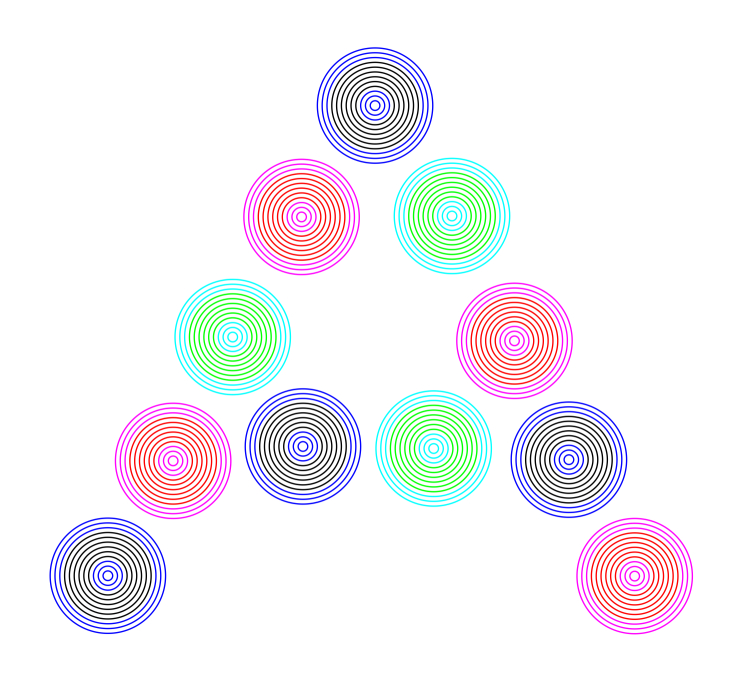
"Kibami A"
The annulus area in each concentric circles appears to be yellowish, though the background is homogeneously white.
Copyright Akiyoshi Kitaoka 2007 (September 27)

"Kibami B"
The annulus area in each concentric circles appears to be yellowish, though the background is homogeneously white.
Copyright Akiyoshi Kitaoka 2007 (September 27)
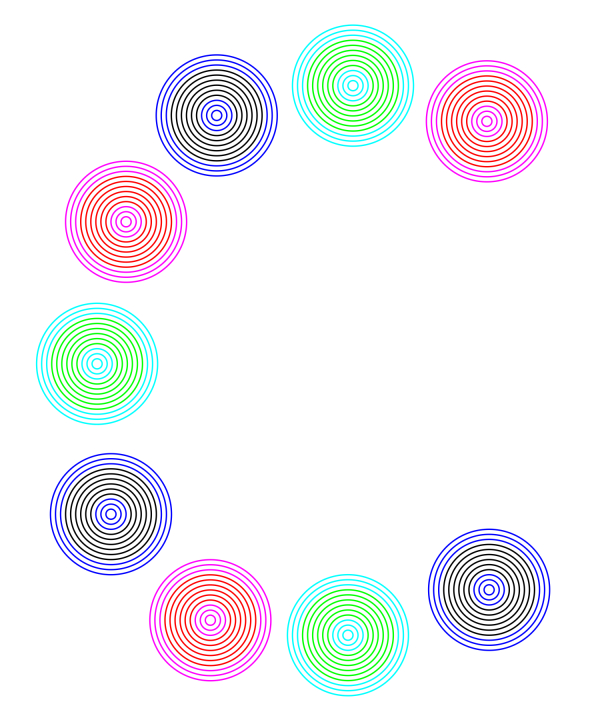
"Kibami C"
The annulus area in each concentric circles appears to be yellowish, though the background is homogeneously white.
Copyright Akiyoshi Kitaoka 2007 (September 27)

"Kibami S"
The annulus area in each concentric circles appears to be yellowish, though the background is homogeneously white.
Copyright Akiyoshi Kitaoka 2007 (September 27)
cf.
Van Tuijl, H. F. J. M. (1975). A new visual illusion: Neonlike color spreading and complementary color induction between subjective contours. Acta Psychologica, 39, 441-445.
Sohmiya, S. (2005) Explanation for neon color effect in achromatic line segments on chromatic inducers based on the multiple interprertation hypothesis. Perceptual and Motor Skills, 101, 267-282.
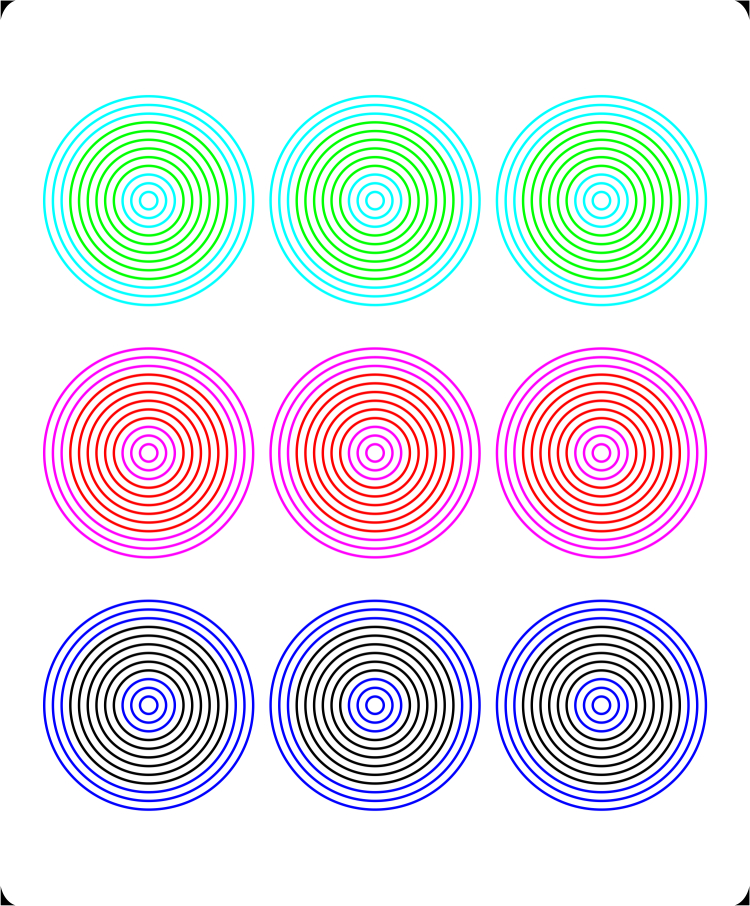
"Nine dots"
The annulus area in each concentric circles appears to be yellowish, though the background is homogeneously white.
Copyright Akiyoshi Kitaoka 2007 (September 27)
cf.
Van Tuijl, H. F. J. M. (1975). A new visual illusion: Neonlike color spreading and complementary color induction between subjective contours. Acta Psychologica, 39, 441-445.
Sohmiya, S. (2005) Explanation for neon color effect in achromatic line segments on chromatic inducers based on the multiple interprertation hypothesis. Perceptual and Motor Skills, 101, 267-282.

"Kibami"
The center of each lattice appears to be yellowish, though the background is homogeneously white.
Copyright Akiyoshi Kitaoka 2007 (September 19)
cf.
Van Tuijl, H. F. J. M. (1975). A new visual illusion: Neonlike color spreading and complementary color induction between subjective contours. Acta Psychologica, 39, 441-445.
Sohmiya, S. (2005) Explanation for neon color effect in achromatic line segments on chromatic inducers based on the multiple interprertation hypothesis. Perceptual and Motor Skills, 101, 267-282.
Other images




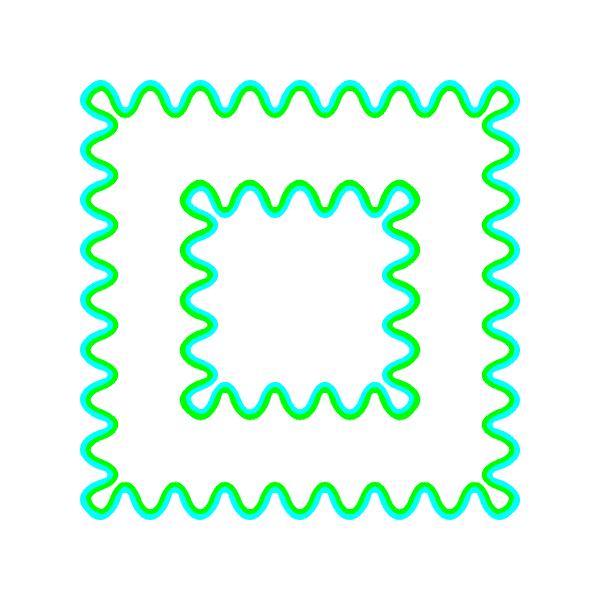


"Paradoxical watercolor effect"
The square ring area (or corridor) appears to be slightly tinted yellow, though there is no yellow.
Copyright Akiyoshi Kitaoka 2007 (June 23)
Watercolor effect (watercolor illusion):
Pinna, B., Brelstaff, G., and Spillmann, L. (2001) Surface color from boundaries: a new ‘watercolor’ illusion. Vision Research, 41, 2669-2676.
Samples of watercolor illusion

"A grapefruit"
It appears as if white mist surrounded the grapefruit..
Copyright Akiyoshi Kitaoka 2005 (April 6)

"Cutting off"
It appears as if boosters were cutted off from a rocket where the white background appears to shine. In addition, the rocket appears to ascend while the boosters appear to fall.
Copyright A.Kitaoka 2005 (June 11)
Visual phantom illusion --- Central drift illusion

"Receding color"
Each of the round-cornered, illusory square appears to contract.
Copyright A.Kitaoka 2004 (June 11)
The squares are formed by a variation of Varin's figure. Although some researchers call Varin's figure as neon color spreading(1), Varin's figure should be attributed to the photopic visual phantom illusion in our opinion(2). However, it seems that Varin (1971) made both(3). In our research, too, phenomenal and spatial-frequency characteristics were similar to each other between neon color spreading and visual phantoms(4). In addition, the contracting effect in this figure is due to the peripheral drift illusion(5). Similar demonstration can be seen in van Lier's (2002) Figure 1b(6). The title words "receding color" usually refer to the phenomenon that blue appears to be farther than red(7).
(1) Nakayama, K., Shimojo, S., and Ramachandran, V. S. (1990). Transparency: Relation to depth, subjective contours, luminance, and neon color spreading. Perception, 19, 497-513.
(2) Kitaoka, A., Gyoba, J., and Kawabata, H. (1999). Photopic visual phantom illusion: Its common and unique characteristics as a completion effect. Perception, 28, 825-834.
(3) Bressan, P., Mingolla, E., Spillmann, L., & Watanabe, T. (1997). Neon color spreading: A review. Perception, 26, 1353-1366.
Varin, D. (1971) Fenomeni di contrasto e diffusione cromatica nell'organizzazione
spaziale del campo percettivo. Rivista di Psicologia, 65, 101-128.
(4) Kitaoka, A., Gyoba, J., Kawabata, H., and Sakurai, K. (2001). Two competing mechanisms underlying neon color spreading, visual phantoms and grating induction. Vision Research, 41, 2347-2354.
(5) Kitaoka, A. and Ashida, H. (2003) Phenomenal characteristics of the peripheral drift illusion. Vision (Japan), 15, 261-262. PDF
(6) van Lier, R. (2002) A double neon color illusion. Perception, 31, 31-38.
(7) Chromostereopsis
Elemental figures of visual completion
(These images can be used freely if the names are correctly described)
 Kanizsa's figure. It appears as if a white square were in front of four black circles. |
 Neon color spreading. Color appears to spread into the homogeneously white background. |
 Varin's figure. It appears as if a blue square were in front of four black circles. |
 Visual phantoms. Vertical black stripes appear to be continual and be in front of the horizontal black region. |
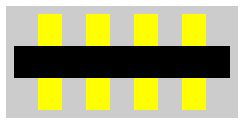 Photopic phantoms. Yellow stripes appear to be continual behind the homogeneously black rectangle. |